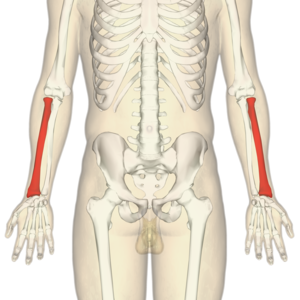Radius
Original Editor
Top Contributors - Abbey Wright, Kim Jackson, Joao Costa, Chrysolite Jyothi Kommu, Amanda Ager and Pacifique Dusabeyezu
Description[edit | edit source]
The radius is one of the two bones that make up the forearm, the other being the ulna. It forms the radio-carpel joint at the wrist and the radio-ulnar joint at the elbow. It is in the lateral forearm when in the anatomical position. It is the smaller of the two bones.
Structure[edit | edit source]
Proximal radius[edit | edit source]
The proximal radius consists of the radial head, neck and tuberosity.
The radial head is cylindrical which articulates with the capitellum of the humerus[1]. The head rotates within the annular ligament to produce supination and pronation of the forearm.[2]
The neck and tuberostiy support the head and provide points of attachments for supinator brevis and biceps bracii.[1]
Radial shaft[edit | edit source]
The shaft of the radius is slightly curved into convex from the body. The majority of the shaft has three borders: anterior, posterior and interosseous.
Distal radius[2][edit | edit source]
The distal radius has five surfaces:
- Lateral - which extends to form the styloid process
- Medial - consists of a concave ulnar notch to articulate with the ulnar head in pronation
- Posterior - convex and contains a prominent ridge called Lister's tubercle
- Anterior - smooth and forms a distinct margin
- Distal articular surface - articulates laterally with scaphoid and medially with lunate
Function[edit | edit source]
The radius' main functions are to articulate with the ulna and humerus at the elbow to provide supination and pronation. Then to articulate with the lunate and scaphoid to provide all the movements of the wrist.
Articulations[edit | edit source]
Elbow[edit | edit source]
The radius articulates with the ulna in a synovial pivot joint.
Wrist[edit | edit source]
Muscle attachments[edit | edit source]
Clinical relevance[edit | edit source]
Most commonly injured by fracture: fall on outstretched hand (FOOSH) commonly referred to as colles fracture.








